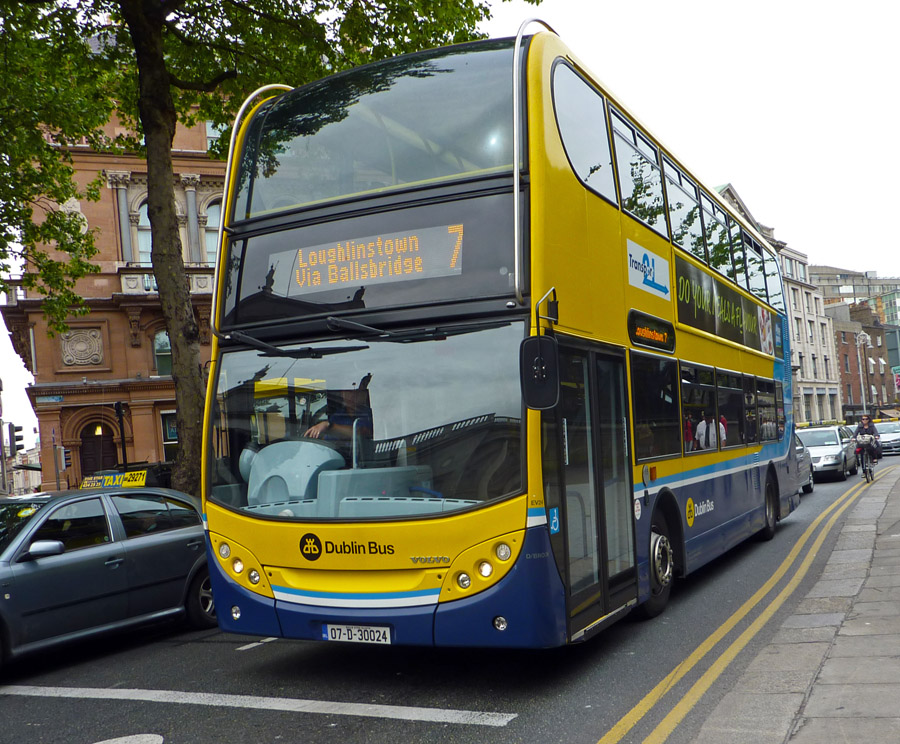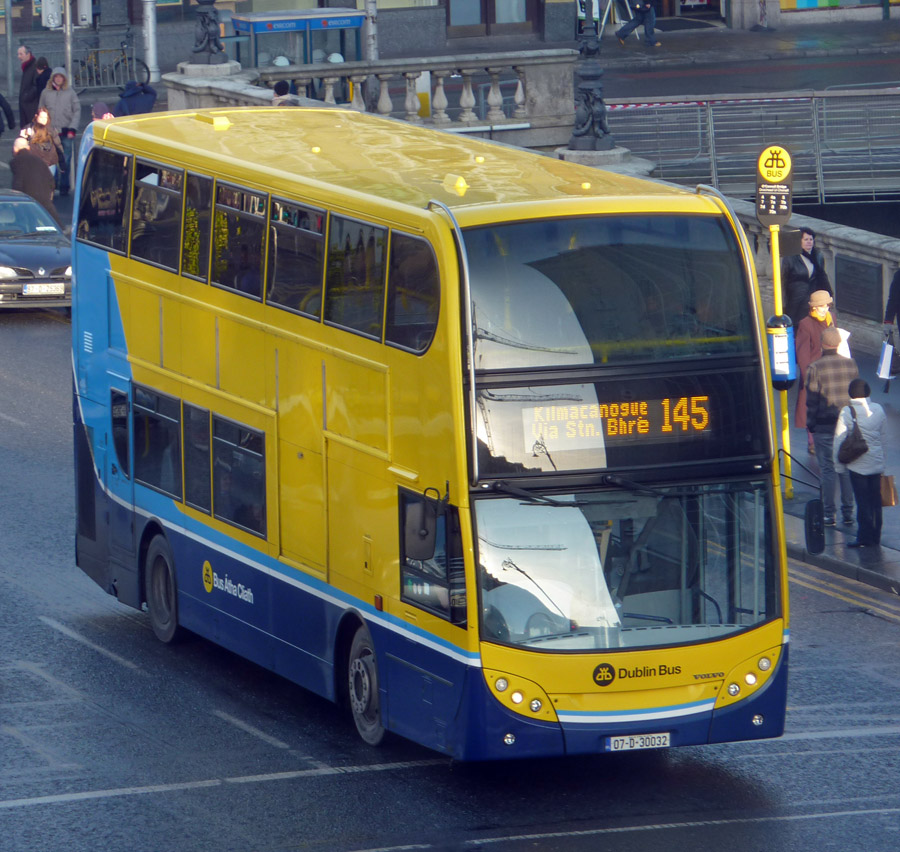Photo of the Week - Week 28:

Alexander Dennis Enviro 400 bodied Volvo B9TL, EV24, operating a Route 7 departure to Loughlinstown Park on the 31st May 2010.
An EV operating Route 7 is a rare sight hence its selection as image of the week 28. EV24 entered service in Donnybrook Garage on the 14th October 2007. By the beginning of 2008, it and EV32 were mostly to be seen operating cross-city Route 11. More recently it has been within the 145 allocation with the rest of the Donnybrook EVs, so its appearance on the 7 was enough of a rarity for a city centre shot to be selected.
EV24 along with EV32, AX449 and AX544 were fitted with transmitter devices in early 2008 in order for them to provide real time information to the garage. This trial was the precursor to the fleet wide Automatic Vehicle Location (AVL) system that is currently been installed. The first real time information panel for this system has been installed on the Howth Road (Corner of Sybil Hill Road), but is as of yet not operational.
Of course this is not the first time an AVL system has been in operation in Dublin Bus. Traffic congestion in Dublin has always been an issue. As far back as the 50s measures were being put in place to improve situations. The requirement within any bus company is to know the exact location of its buses and any traffic problems within their operational area that might affect journey times. The initial solution was to have area inspectors, who regulated bus departures at termini. These worked in conjunction with stance inspectors at important locations within the city. Using a network of telephones at these locations it was possible for inspectors to relay information to one another and to regulate bus departures, turn buses short, provide an extra bus, run special etc... in order to provide the best possible service.
Of course this system wasn't that successful, in fact much bad publicity came from its use, with waiting passengers frequently finding that these interventions were neither intelligent nor beneficial to the user. With the development of integrated circuits in the 60s it was possible to make light weight low power radios, much more efficient than their high powered predecessors. In the summer of 1969 35 buses operating routes 19/A from Summerhill Depot were equipped with open-call radio telephones, controlled by one stance inspector in 59 O'Connell Street. CCTV was used at two major queuing points and fleet numbers were placed on the roofs of buses in order for them to be more visible. The 19/A at this stage had new modern D class Atlantean buses in operation which may have been why it was selected.
Waiting times on Route 19/A were cut by 25% with the new scheme. However the open-call system heavily used radio frequencies to which CIE had only a limited access to and CIE could not continue its roll out. CIE therefore designed a Automatic Vehicle Monitoring (AVM) system that used the available radio frequencies more efficiently while being able to supply full fleet coverage. But the AVM system offered more than a two-way radio that had previously been used. The bus locations would also be transmitted by the AVM with the information being processed by a computer and a resultant position of the bus being visualised on a computer screen. With this accurate information corrective measures could be made on routes in order to alleviate passenger waiting times.
The system was in fact quite basic but highly ingenious given the technological limitations imposed by the primitive computers available in the 1970s. The AVM relayed information about the position of the bus by monitoring its speedometer. By monitoring both the time and the speed it could give an accurate indication of the route position of a particular bus. A 90-day trial in Phibsborough Garage took place in late 1975/early 1976. The test was very successful however its fleet-wide usage was hampered by the resistance of the crews to the system.
In fact it was a further seven years, with numerous wranglings in the Labour Court, before the system went fleet wide. The system received international acclaim, in fact CIE held an International Symposium for other public transport operators explaining the details of the AVM. Toronto's Transit Authority bought the AVM for use on their system. So far ahead of its time it even appeared on "Tomorrow's World" on the BBC. This system represented something brand new for bus operation. It was far ahead of anything on offer in major cities like London.
But like many things the struggles in getting it to be used, never mind being used properly, meant that CIE never truly received the benefits of the ingenuity of some of its staff. Internal conflicts plagued CIE and its a pity the system didn't find favour immediately.
The system was quite basic by modern standards and so, with the Department indicating that a new AVL system would be funded, Dublin Bus decided to remove the AVM from its fleet. However, like many things the AVL was not funded. The company performed its own trials on the Lucan Corridor etc... but the funding from the Department was extremely slow coming. Therefore Dublin Bus had to again rely on stance inspectors and radio-calls to drivers without ever knowing the exact location or speed of its buses.
Finally in the summer 2008 it was announced that a new AVL system would be installed system wide. Work on this has been ongoing and one hopes that its system wide introduction finds less opposition than it did in the 70s and 80s.

The other EV used in the AVL trial, EV32 is seen operating on the 145 on a misty 22nd December 2009 morning on O'Connell Bridge.
